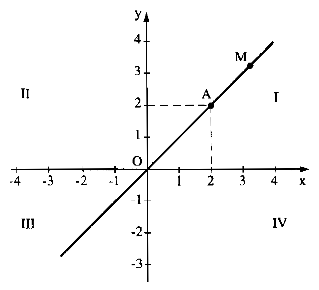

Hãy nhập câu hỏi của bạn vào đây, nếu là tài khoản VIP, bạn sẽ được ưu tiên trả lời.



- Vẽ trục tọa độ Oxy và biểu diễn các điểm:
- Tứ giác ABCD là hình vuông.
tick nha

a) Cho \(3x^2-4x=0\)
\(\Rightarrow3.x.x-4x=0\)
\(\Rightarrow x.\left(3x-4\right)\) = 0
\(\left[{}\begin{matrix}x=0\\3x-4=0\end{matrix}\right.\)
Có \(3x - 4 =0\)
\(\Rightarrow3x=4\)
\(\Rightarrow x=\dfrac{4}{3}\)
Vậy x= 0 hoặc x =\(\dfrac{4}{3}\)là nghiệm của đa thức \(3x^2-4x\)
b) Cho \(x+3x^2=0\)
\(\Rightarrow x+3.x.x=0\)
\(\Rightarrow x.\left(3x+1\right)=0\)
Suy ra x =0
hoặc \(3x+1=0\)
\(\Rightarrow\)3x=-1
x=\(\dfrac{-1}{3}\)
Vậy ...
Bài 3: Tìm nghiệm các đa thức sau:
a. 3x2 - 4x
Gọi P(x) là đa thức 3x2 - 4x.
Cho P(x) = 0
=> 3x2 - 4x = 0
=> x (3x - 4)= 0
Suy ra:
TH1: x = 0
TH2: 3x - 4 = 0
_____3x___= 0 + 4
_____3x___= 4
______x___= \(\dfrac{4}{3}\)
Vậy x = \(\dfrac{4}{3}\) là nghiệm của đa thức 3x2 - 4x.
b. x + 3x2
Gọi Q(x) là đa thức x+3x2
Cho Q(x) = 0
=> x+3x2 = 0
=> x ( 3x) = 0
Suy ra:
TH1: x = 0
TH2: 3x = 0
=> x = 0.
Vậy x = 0 là nghiệm của đa thức x + 3x2 .
Chúc bn hx tốt!

a.\(12,5.\left(-\dfrac{5}{7}\right)+1,5.\left(-\dfrac{5}{7}\right)\)
\(=\left(-\dfrac{5}{7}\right).\left(12,5+1,5\right)\)
\(=-10\)
b,\(\left(-\dfrac{2}{5}-\dfrac{3}{7}\right):\dfrac{4}{5}+\left(-\dfrac{1}{5}+\dfrac{3}{7}\right):\dfrac{4}{5}\)
\(=\left(-\dfrac{2}{5}-\dfrac{3}{7}-\dfrac{1}{5}+\dfrac{3}{7}\right):\dfrac{4}{5}\)
\(=-\dfrac{3}{5}:\dfrac{4}{5}\)
\(=-\dfrac{3}{4}\)
c,\(12.\left(-\dfrac{2}{3}\right)^2+\dfrac{4}{3}\)
\(=12.\dfrac{4}{9}+\dfrac{4}{3}\)
\(=\dfrac{16}{3}+\dfrac{4}{3}\)
\(=\dfrac{20}{3}\)
d,\(1:\left(\dfrac{2}{3}-\dfrac{3}{4}\right)^2\)
\(=\dfrac{1}{1}:\dfrac{1}{144}\)
\(=144\)
e,\(15.\left(-\dfrac{2}{3}\right)^2-\dfrac{7}{3}\)
\(=15.\dfrac{4}{9}-\dfrac{7}{3}\)
\(=\dfrac{20}{3}-\dfrac{7}{3}\)
\(=\dfrac{13}{3}\)
a) = ( 12,5 +1,5 ). \(\left(-\dfrac{5}{7}\right)\)
= 14 . \(\left(-\dfrac{5}{7}\right)\)
= -10
b) = (\(-\dfrac{2}{5}+-\dfrac{1}{5}\)) + \(\left(\dfrac{3}{7}-\dfrac{3}{7}\right)\): \(\dfrac{4}{5}\)
= \(\left(-\dfrac{3}{5}+0\right)\): \(\dfrac{4}{5}\)
= \(\dfrac{3}{4}\)
c) = \(\left(12.-\dfrac{2}{9}\right)\) + \(\dfrac{4}{3}\)
= \(\dfrac{8}{3}\) + \(\dfrac{4}{3}\)
= \(-\dfrac{4}{3}\)
d) = 1: \(\dfrac{23}{48}\)
=\(\dfrac{48}{23}\)
e) =\(\left(15.-\dfrac{2}{9}\right)-\dfrac{7}{3}\)
= \(\left(-\dfrac{10}{3}\right)-\dfrac{7}{3}\)
=\(-\dfrac{17}{3}\)
f) = 10 485.76